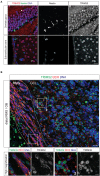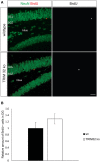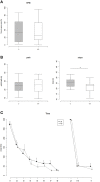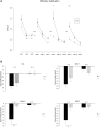The neural stem cell fate determinant TRIM32 regulates complex behavioral traits
- PMID: 25852471
- PMCID: PMC4364253
- DOI: 10.3389/fncel.2015.00075
The neural stem cell fate determinant TRIM32 regulates complex behavioral traits
Abstract
In mammals, new neurons are generated throughout the entire lifespan in two restricted areas of the brain, the dentate gyrus (DG) of the hippocampus and the subventricular zone (SVZ)-olfactory bulb (OB) system. In both regions newborn neurons display unique properties that clearly distinguish them from mature neurons. Enhanced excitability and increased synaptic plasticity enables them to add specific properties to information processing by modulating the existing local circuitry of already established mature neurons. Hippocampal neurogenesis has been suggested to play a role in spatial-navigation learning, spatial memory, and spatial pattern separation. Cumulative evidences implicate that adult-born OB neurons contribute to learning processes and odor memory. We recently demonstrated that the cell fate determinant TRIM32 is upregulated in differentiating neuroblasts of the SVZ-OB system in the adult mouse brain. The absence of TRIM32 leads to increased progenitor cell proliferation and less cell death. Both effects accumulate in an overproduction of adult-generated OB neurons. Here, we present novel data from behavioral studies showing that such an enhancement of OB neurogenesis not necessarily leads to increased olfactory performance but in contrast even results in impaired olfactory capabilities. In addition, we show at the cellular level that TRIM32 protein levels increase during differentiation of neural stem cells (NSCs). At the molecular level, several metabolic intermediates that are connected to glycolysis, glycine, or cysteine metabolism are deregulated in TRIM32 knockout mice brain tissue. These metabolomics pathways are directly or indirectly linked to anxiety or depression like behavior. In summary, our study provides comprehensive data on how the impairment of neurogenesis caused by the loss of the cell fate determinant TRIM32 causes a decrease of olfactory performance as well as a deregulation of metabolomic pathways that are linked to mood disorders.
Keywords: adult neurogenesis; brain metabolism; cell fate determinant; neural stem cells; olfactory behavior.
Figures






Similar articles
-
TRIM32-dependent transcription in adult neural progenitor cells regulates neuronal differentiation.Cell Death Dis. 2013 Dec 19;4(12):e976. doi: 10.1038/cddis.2013.487. Cell Death Dis. 2013. PMID: 24357807 Free PMC article.
-
Social Cues, Adult Neurogenesis, and Reproductive Behavior.In: Mucignat-Caretta C, editor. Neurobiology of Chemical Communication. Boca Raton (FL): CRC Press/Taylor & Francis; 2014. Chapter 13. In: Mucignat-Caretta C, editor. Neurobiology of Chemical Communication. Boca Raton (FL): CRC Press/Taylor & Francis; 2014. Chapter 13. PMID: 24830028 Free Books & Documents. Review.
-
Running-Activated Neural Stem Cells Enhance Subventricular Neurogenesis and Improve Olfactory Behavior in p21 Knockout Mice.Mol Neurobiol. 2019 Nov;56(11):7534-7556. doi: 10.1007/s12035-019-1590-6. Epub 2019 May 6. Mol Neurobiol. 2019. PMID: 31062248
-
The functional significance of newly born neurons integrated into olfactory bulb circuits.Front Neurosci. 2014 May 26;8:121. doi: 10.3389/fnins.2014.00121. eCollection 2014. Front Neurosci. 2014. PMID: 24904263 Free PMC article. Review.
-
Effects of maternal immune activation on adult neurogenesis in the subventricular zone-olfactory bulb pathway and olfactory discrimination.Schizophr Res. 2013 Dec;151(1-3):1-11. doi: 10.1016/j.schres.2013.09.007. Epub 2013 Oct 7. Schizophr Res. 2013. PMID: 24113206
Cited by
-
Whole Exome Sequencing Study Identifies Novel Rare Risk Variants for Habitual Coffee Consumption Involved in Olfactory Receptor and Hyperphagia.Nutrients. 2022 Oct 16;14(20):4330. doi: 10.3390/nu14204330. Nutrients. 2022. PMID: 36297015 Free PMC article.
-
Stromal Cell-Derived Factor-1α Plays a Crucial Role Based on Neuroprotective Role in Neonatal Brain Injury in Rats.Int J Mol Sci. 2015 Aug 5;16(8):18018-32. doi: 10.3390/ijms160818018. Int J Mol Sci. 2015. PMID: 26251894 Free PMC article.
-
Expression of the Parkinson's Disease-Associated Gene Alpha-Synuclein is Regulated by the Neuronal Cell Fate Determinant TRIM32.Mol Neurobiol. 2017 Aug;54(6):4257-4270. doi: 10.1007/s12035-016-9989-9. Epub 2016 Jun 23. Mol Neurobiol. 2017. PMID: 27339877
-
Multimodal insights into adult neurogenesis: An integrative review of multi-omics approaches.Heliyon. 2025 Feb 13;11(4):e42668. doi: 10.1016/j.heliyon.2025.e42668. eCollection 2025 Feb 28. Heliyon. 2025. PMID: 40051854 Free PMC article. Review.
-
Itaconic acid indicates cellular but not systemic immune system activation.Oncotarget. 2018 Aug 14;9(63):32098-32107. doi: 10.18632/oncotarget.25956. eCollection 2018 Aug 14. Oncotarget. 2018. PMID: 30181801 Free PMC article.
References
-
- Belluzzi O., Benedusi M., Ackman J., LoTurco J. J. (2003). Electrophysiological differentiation of new neurons in the olfactory bulb. J. Neurosci. 23, 10411–10418. Available online at: http://www.jneurosci.org/content/23/32/10411.full - PMC - PubMed
LinkOut - more resources
Full Text Sources
Other Literature Sources
Molecular Biology Databases
Miscellaneous

